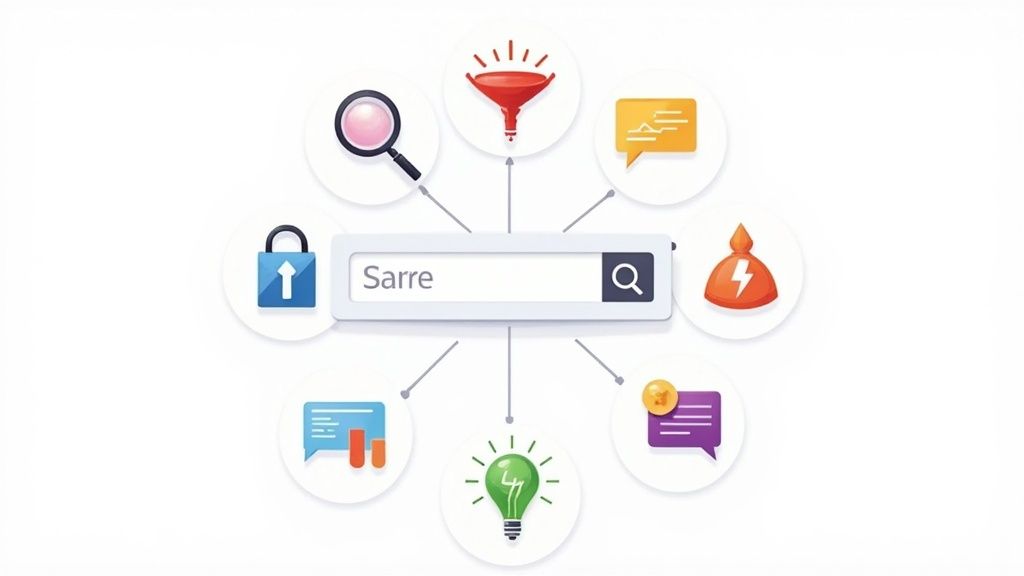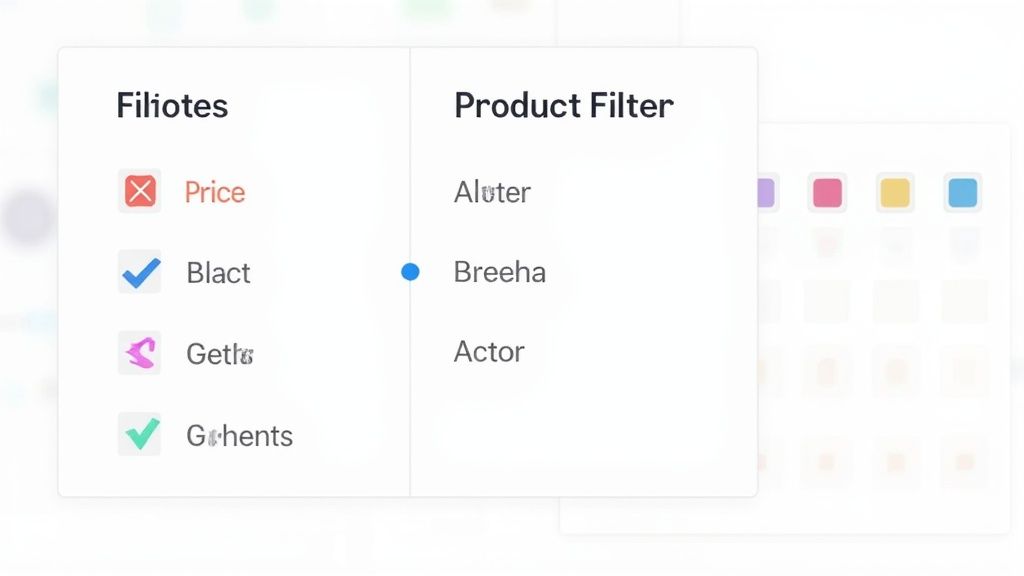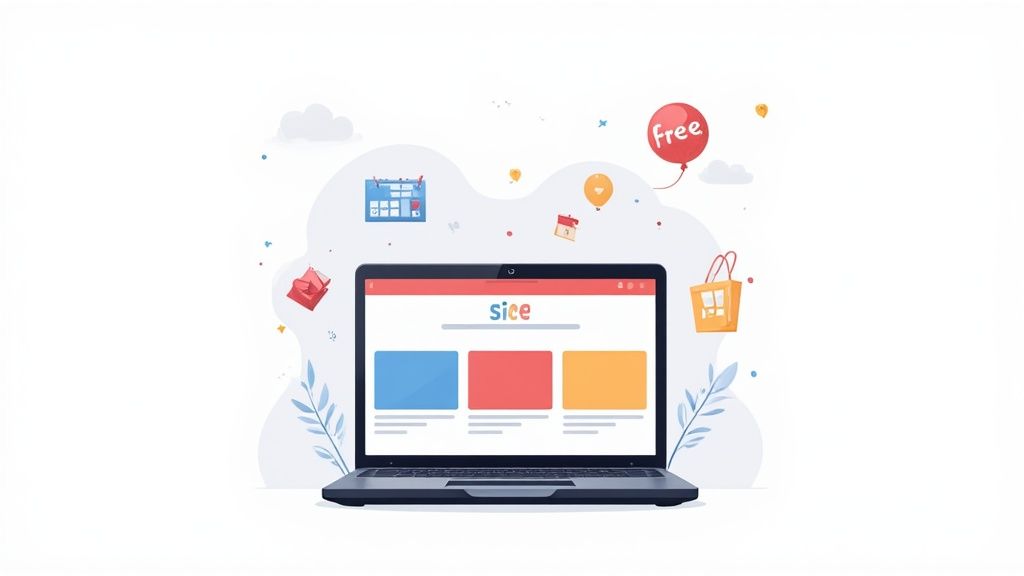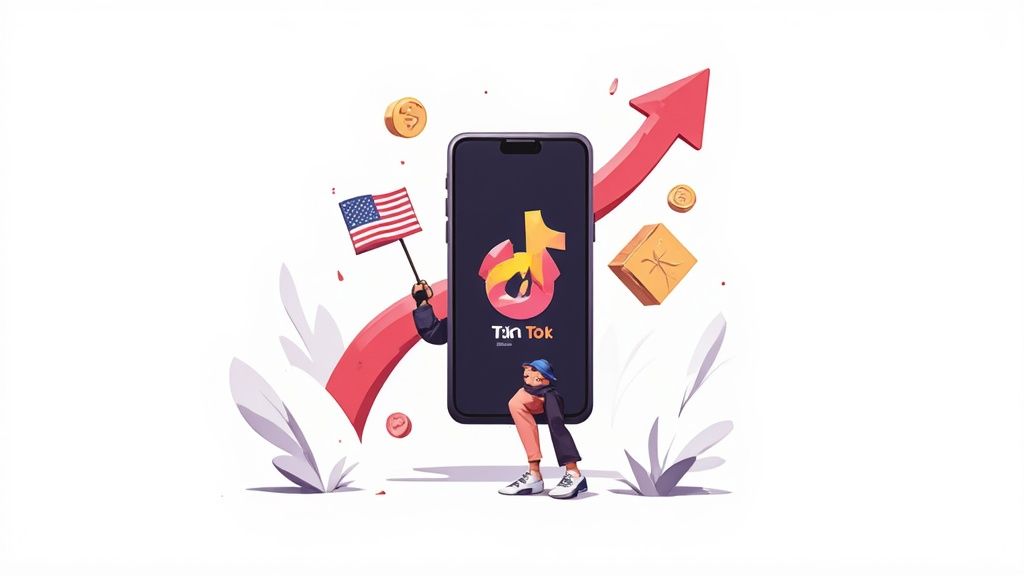
In the competitive world of ecommerce, your site's search bar is more than just a navigation tool; it's a direct line to your customer's intent. Shoppers who use search are significantly more likely to convert because they arrive with a clear purpose. Failing to provide a fast, intuitive, and relevant search experience is like having a salesperson who ignores customers or points them in the wrong direction. A poor search function doesn't just cost you a single transaction; it erodes trust and sends high-intent buyers straight to your competitors.
This guide moves beyond generic advice to deliver a comprehensive roundup of actionable ecommerce site search best practices. We will cover a range of critical strategies designed to transform your search functionality from a simple utility into a powerful conversion engine.
You will learn how to implement:
- AI-powered personalization and visual search.
- Advanced filtering and natural language understanding.
- Crucial optimizations for 'zero results' pages and mobile design.
By implementing these proven techniques, you will not only reduce user frustration but also actively turn search queries into sales. This article provides the blueprint to make your search bar your store's most effective and highest-performing asset.
1. Intelligent Auto-Suggest and Autocomplete
Intelligent auto-suggest, also known as autocomplete, is a dynamic search feature that predicts a user's intent and provides real-time suggestions as they type. This predictive functionality goes beyond simple word completion; it serves as a powerful navigation and discovery tool. By instantly showing popular searches, specific product names, relevant categories, and even brands, you guide users toward their desired items faster and reduce the chance of a "no results" page. This proactive assistance is a cornerstone of modern ecommerce site search best practices, significantly improving user experience and conversion rates.

This feature helps minimize typing errors, especially on mobile devices, and introduces customers to products they might not have known how to search for directly. For example, a user typing "run" could see suggestions for "running shoes," "running shorts," and the brand "Brooks Running," each leading them down a highly relevant path.
Actionable Implementation Tips
- Curate Suggestion Types: Don't just show keyword suggestions. Include a mix of product names, categories, and brand suggestions. Advanced implementations, like those on Etsy, even display small product images directly in the dropdown, offering immediate visual confirmation.
- Limit and Prioritize: Avoid overwhelming users. Display a focused list of 8 to 10 suggestions at most. Prioritize these suggestions based on popularity, recent search trends, or business goals like promoting high-margin items.
- Ensure Keyboard Accessibility: Implement full keyboard navigation. Users should be able to type, use the arrow keys to select a suggestion, and press Enter to execute the search without ever needing their mouse.
- Optimize for Typos: A truly intelligent system incorporates typo tolerance. If a user types "shrit," the autosuggest should still confidently recommend "shirt" or "t-shirt." This prevents user frustration and search abandonment at the earliest stage.
2. Advanced Filtering and Faceted Search
Advanced filtering, often implemented as faceted search, is a crucial tool that empowers users to systematically narrow down large sets of search results. Instead of forcing customers to sift through hundreds or thousands of products, faceted search provides a structured set of filters (facets) like brand, price, size, and color. Users can apply multiple filters simultaneously, refining the product list with each selection until they find exactly what they need. This interactive and intuitive process is a fundamental ecommerce site search best practice, transforming a potentially overwhelming catalog into a manageable and personalized shopping experience.

By allowing customers to control their discovery journey, you significantly reduce friction and bounce rates. For instance, sites like Best Buy masterfully use technical facets such as screen size, resolution, and processor type, while fashion retailers like ASOS use visual filters for color and detailed options for size and fit. This level of control helps users make confident purchasing decisions faster.
Actionable Implementation Tips
- Prioritize Filters with Data: Analyze your search analytics and user behavior to determine which filters are most valuable. Place the most frequently used facets, like size, brand, and price, at the top of the filter sidebar for easy access.
- Display Result Counts: Show the number of available products next to each filter option. This provides immediate feedback, preventing users from clicking into a dead-end with zero results and helping them gauge the impact of their selections.
- Use Progressive Disclosure: For categories with numerous filters, avoid overwhelming users with a long list. Show the most critical filters by default and hide less common ones behind a "Show More" link. This keeps the interface clean and focused.
- Implement Thematic and Visual Filters: Go beyond basic text filters. For apparel, use color swatches instead of just color names. For home goods, consider filters for "material" or "style" (e.g., Mid-Century Modern, Industrial). These thematic filters align better with how shoppers think.
3. Visual Search and Image Recognition
Visual search allows customers to find products using an image instead of text, transforming a smartphone camera into a powerful discovery tool. This technology addresses a common shopping challenge: "I know what I want when I see it, but I don't know how to describe it." By letting users upload a photo or use their live camera to find similar items, you cater directly to the visually-driven, mobile-first shopper. This capability is a game-changer for industries like fashion, home decor, and beauty, where appearance is paramount, and it represents one of the most innovative ecommerce site search best practices available today.

When a customer sees a piece of furniture in a magazine or a dress on the street, visual search eliminates the guesswork of keyword searching. Major retailers like ASOS with its "Style Match" feature and The Home Depot have successfully implemented this to bridge the gap between inspiration and purchase, allowing users to find visually similar products in their catalog instantly. It creates a seamless, intuitive, and often delightful user experience that can significantly boost engagement and conversions.
Actionable Implementation Tips
- Prioritize High-Impact Categories: Roll out visual search strategically. Start with categories where visual attributes are the primary purchase driver, such as apparel, accessories, furniture, or home goods, to maximize your return on investment.
- Provide Clear User Guidance: Don't assume users know how it works. Use simple icons and brief text prompts to guide them on how to upload a photo or use their camera. Instruct them on capturing clear, well-lit images for the best results.
- Combine with Traditional Filters: Visual search results are a starting point. Allow users to refine these image-based results further using traditional filters like brand, price, color, and size. This combination of visual discovery and logical filtering creates a powerful shopping journey.
- Continuously Train the AI Model: The accuracy of your visual search depends on the AI model behind it. Regularly feed it new product images, including user-generated content and lifestyle shots, to improve its ability to recognize items and return relevant matches.
4. Personalized Search Results
Personalized search results transform a generic, one-size-fits-all search function into a dynamic, customer-aware concierge. This advanced practice involves customizing the order and content of search results based on an individual's unique data, including their purchase history, browsing patterns, wish lists, and stated preferences. By doing so, you create a shopping experience that feels uniquely tailored to each user, dramatically increasing the relevance of every query. This level of personalization is a cornerstone of modern ecommerce site search best practices, helping to build loyalty and drive conversions by showing customers exactly what they are most likely to buy.
This approach ensures that a repeat customer searching for "foundation" sees results that match their previously purchased shade or skin type, while a new user might see top-sellers first. Amazon famously pioneered this, where search results for a term like "headphones" are heavily influenced by whether you've previously purchased or browsed for specific brands like Bose or Sony.
Actionable Implementation Tips
- Start with Purchase History: The most powerful and straightforward personalization signal is past behavior. Prioritize brands, categories, or product attributes a user has previously purchased. If a customer always buys a specific brand of dog food, that brand should rank first in their subsequent "dog food" searches.
- Balance Personalization and Discovery: While tailoring results is key, avoid creating a "filter bubble" that hides new or relevant products. Mix personalized suggestions with popular items or "new arrivals" to encourage serendipitous discovery and prevent a stale experience.
- Ensure Transparency and Control: Adhere strictly to privacy regulations like GDPR and CCPA by being transparent about data usage. Provide users with clear options to manage their personalization preferences or even reset their search history, giving them ultimate control over their experience.
- A/B Test Your Algorithms: Personalization is not a "set it and forget it" feature. Continuously A/B test your personalization models. Test different data signals, weighting, and algorithms to determine which strategies most effectively increase key metrics like click-through rate, add-to-cart rate, and overall revenue per search.
5. Voice Search Optimization
Voice search optimization adapts your ecommerce site search to handle spoken queries from voice assistants like Alexa, Siri, and Google Assistant. This technology is crucial as user behavior shifts towards conversational interactions. Spoken queries are typically longer, more natural, and question-based compared to their typed counterparts, requiring a search engine that can process natural language effectively. Optimizing for voice is a key ecommerce site search best practice, ensuring you capture intent from a growing segment of hands-free, on-the-go shoppers.

This goes beyond just having a microphone icon on your search bar. It involves structuring your product data and search logic to answer direct questions. For instance, a user might ask, "show me waterproof running shoes under $100," a complex query that a traditional keyword-based search might fail to understand. Retailers like Walmart and Target have successfully integrated with Google Assistant, allowing users to build shopping lists and order products using only their voice, demonstrating the power of a well-executed voice strategy.
Actionable Implementation Tips
- Target Conversational Keywords: Shift your SEO focus to include long-tail, conversational phrases. Instead of just "red dress," optimize for queries like "find me a long-sleeve red cocktail dress for a winter party." Use your site search analytics to identify how users are already searching.
- Focus on Question-Based Queries: Structure your product descriptions and FAQ pages to directly answer "what," "how," "which," and "where" questions. This helps your search engine and external voice assistants pull accurate answers, like "Which laptops have a backlit keyboard?"
- Implement Natural Language Processing (NLP): Your search engine needs NLP capabilities to deconstruct conversational queries into searchable attributes (e.g., color, style, price). This allows it to understand intent rather than just matching keywords.
- Ensure Schema Markup is Robust: Use structured data (schema.org) for products, prices, and availability. This gives voice assistants the clean, organized information they need to provide direct, rich answers and makes your products more visible in voice-initiated searches.
6. Smart Search Analytics and Optimization
Smart search analytics involves the comprehensive tracking and analysis of user search behavior to continuously refine and improve search functionality. This goes far beyond simply knowing what people search for; it’s about understanding the entire user journey, from the initial query to the final purchase. By monitoring metrics like top search terms, zero-result queries, click-through rates on results, and conversion rates from search, you gain a data-driven roadmap for optimization. This practice is a cornerstone of effective ecommerce site search best practices, transforming your search bar from a simple tool into a powerful business intelligence engine.
Retailers that leverage search analytics can identify hidden product demand, uncover content gaps, and pinpoint user friction points. For instance, a high volume of searches for "waterproof jacket" that result in zero clicks could indicate that your product descriptions lack that specific keyword or that the results shown are irrelevant. Platforms like Shopify and Magento offer built-in search term reports, while tools like Google Analytics provide deeper insights into search-driven behavior.
Actionable Implementation Tips
- Focus on Zero-Result Queries: Regularly generate reports on search terms that yield no results. These represent lost revenue and clear customer demand. Use this data to create new product categories, add relevant synonyms, or inform your product procurement strategy.
- Track Post-Search Engagement: Don't just track the query; track what users do after searching. Analyze click-through rates (CTR) for specific positions on the results page. A low CTR for top-ranked products might signal a problem with product images, pricing, or titles.
- Establish Automated Alerts: Set up automated alerts for significant drops in search performance, such as a sudden spike in "no results" pages or a drop in search-to-conversion rate. This allows you to react quickly to technical issues or shifting customer trends.
- A/B Test Your Changes: When you use analytics to identify a potential improvement, such as changing result sorting or updating synonyms, validate it with rigorous testing. You can explore how to effectively implement these experiments by learning more about A/B testing best practices to ensure your changes lead to positive outcomes.
7. Mobile-First Search Design
Mobile-first search design is an approach that prioritizes the user experience on smaller screens and touch interfaces before designing for larger desktop displays. With mobile commerce now accounting for the majority of ecommerce traffic, treating the mobile search experience as an afterthought is a costly mistake. This design philosophy directly addresses the unique challenges and behaviors of mobile shoppers, such as limited screen real estate, on-the-go context, and reliance on thumb-based navigation. By starting with mobile, you ensure that this crucial customer segment receives a seamless, intuitive, and efficient search experience, which is a cornerstone of modern ecommerce site search best practices.
This approach focuses on clarity and speed, minimizing typing and maximizing discovery. For instance, Amazon's mobile app incorporates barcode scanning and visual search, while fashion retailers like Zalando prioritize large, swipeable product images over dense text. These features cater directly to mobile user habits, making the path to purchase faster and more engaging. Effective mobile-first search design also heavily relies on intuitive user interfaces; explore key mobile app UI design best practices to enhance usability.
Actionable Implementation Tips
- Prioritize Thumb-Friendly Touch Targets: Ensure search bars, buttons, and filter toggles are large enough and positioned within easy reach of a user's thumb. This simple ergonomic consideration prevents mis-taps and frustration.
- Minimize Typing with Smart Suggestions: Since typing on mobile is cumbersome, robust autocomplete and intelligent suggestions are non-negotiable. Feature recent searches, popular queries, and visual product suggestions to reduce user effort. For more on this, you can learn more about ecommerce UX best practices on ecorn.agency.
- Use Progressive Disclosure for Filters: Instead of displaying all filter options at once, which clutters the screen, hide them behind a "Filter" button. Once tapped, filters can appear in a full-screen overlay or a slide-out panel, providing a focused and less overwhelming interface.
- Implement Infinite Scroll for Browsing: On mobile, continuously scrolling through results is often more intuitive than clicking through pagination numbers. This creates a fluid, uninterrupted browsing experience that encourages product discovery.
8. Semantic Search and Natural Language Understanding
Semantic search moves beyond simple keyword matching to understand the user's intent and the contextual meaning behind their query. This advanced technology, powered by Natural Language Understanding (NLU), allows your search engine to interpret conversational language, synonyms, and complex phrases to deliver highly relevant results, even when the exact keywords aren't used. It’s a crucial component of modern ecommerce site search best practices because it bridges the gap between how customers think and how products are cataloged, leading to a more intuitive and successful shopping experience.
This approach transforms your search bar into a knowledgeable sales assistant. For instance, a shopper might search for "a quiet blender that won't wake up the baby" instead of "low decibel blender." A semantic search engine can understand the intent behind "quiet" and "won't wake up the baby" and return products with low noise level specifications. This capability dramatically reduces search abandonment and boosts customer satisfaction by finding the right product without forcing users to guess the correct technical terms.
Actionable Implementation Tips
- Start with Rich Synonym Dictionaries: Before deploying complex AI models, build a robust list of synonyms and related terms. Use customer service chat logs and search query data to identify common language variations for your products, like "sofa" vs. "couch" or "sneakers" vs. "trainers."
- Implement Entity Extraction: Configure your search to recognize and extract key "entities" from queries, such as brand names, product attributes (color, size, material), and technical specifications. A search for "red wool sweater size medium" should correctly identify and filter by each of these three distinct attributes.
- Leverage User Behavior Data: Continuously train your search models with real user data. Track which results are clicked for specific queries and use this information to reinforce the connections between conversational phrases and specific products. This feedback loop is essential for improving accuracy over time.
- Test with Diverse Query Formulations: Actively test your semantic search with a wide range of queries, from simple keywords to long-tail questions. For a camera, test "4k vlogging camera" as well as "best camera for making YouTube videos." This ensures your system can handle the diverse ways real customers search.
9. Zero-Results Page Optimization
A zero-results page, often seen as a dead end, is a critical touchpoint that can either frustrate a user into leaving or guide them toward a successful purchase. Instead of presenting a blank slate or a simple "no results found" message, strategic optimization turns this page into a valuable recovery and discovery tool. By providing helpful alternatives, you acknowledge the user's intent and offer new paths forward, preventing site abandonment. This approach is a fundamental aspect of ecommerce site search best practices, transforming a moment of friction into an opportunity for engagement and conversion.
When a search for a niche or misspelled item fails, a well-designed zero-results page can make all the difference. For instance, if a user searches for "gortex jacket" and finds nothing, the page should suggest the correct spelling "Gore-Tex jacket." It can also display popular items in the "Jackets" category or showcase a curated collection of "Best Selling Outerwear," keeping the user's journey alive and productive.
Actionable Implementation Tips
- Analyze Zero-Result Queries: Regularly review your search analytics for common queries that yield no results. These searches reveal valuable insights into customer demand, potential product catalog gaps, or common synonyms and misspellings you need to add to your search dictionary.
- Offer Alternative Pathways: Don't just show an empty page. Include spelling suggestions, links to relevant categories, and a selection of trending or best-selling products. REI, for example, might suggest activity-based categories like "Hiking Gear" or "Camping Equipment" to redirect the user.
- Provide Clear Navigation and Help: Ensure users can easily navigate back to your homepage or main categories. Including a section with "Search Tips" or a visible link to customer support or a contact form can help users with complex inquiries, salvaging a potential sale.
- Personalize the Recommendations: If possible, use data about the user’s browsing history to personalize the product recommendations on the zero-results page. If they were previously viewing a specific brand, feature products from that brand as an alternative.
Ecommerce Site Search Best Practices Comparison
From Search Bar to Conversion Engine: Your Next Steps
Transforming your website's search bar from a simple utility into a powerful conversion engine is no longer a luxury; it's a fundamental requirement for success in today's competitive digital marketplace. The journey we've explored, from intelligent auto-suggest to robust zero-results page strategies, provides a comprehensive roadmap. Each of the nine best practices discussed serves as a critical pillar in building a search experience that delights customers and drives revenue.
Mastering these ecommerce site search best practices is about shifting your perspective. Instead of viewing search as a passive tool, you must see it as an active, intelligent conversation with your customers. It's an opportunity to understand their intent, anticipate their needs, and guide them effortlessly to the products they desire. The ultimate goal is to make discovery so seamless and intuitive that the path to purchase feels less like a search and more like a personalized recommendation.
Turning Insights into Action
The key takeaway is that a high-performing search experience is not a single feature but a holistic, interconnected system. While implementing visual search or advanced personalization might seem daunting, the process can be broken down into manageable steps.
Your immediate next steps should be grounded in data and strategy:
- Audit Your Current Search: Begin by diving into your search analytics. What are your top search queries? Where are users dropping off? Which searches yield zero results? Identifying these pain points will reveal the most impactful areas for improvement.
- Prioritize Your Initiatives: You don't need to implement everything at once. If your mobile experience is lagging, focus on a mobile-first design. If "no results found" pages have a high exit rate, optimizing them is a quick win that can immediately recover potential sales.
- Embrace Incremental Improvement: Treat your site search as an evolving product. Continuously test, analyze, and refine your approach based on user behavior and performance metrics. A/B testing different autocomplete suggestions or filter placements can yield significant gains over time.
By systematically applying these principles, you move beyond merely having a search function to building a true competitive advantage. A sophisticated search experience directly boosts key metrics like conversion rates, average order value, and customer lifetime value. It fosters brand loyalty by demonstrating that you understand and respect your customers' time and intent, turning a functional interaction into a memorable, positive brand experience.
Ready to transform your site search into your most powerful sales tool? The team at ECORN specializes in implementing advanced, data-driven ecommerce solutions on the Shopify platform. We help ambitious brands implement these exact ecommerce site search best practices to unlock new revenue streams and enhance the customer journey. Visit ECORN to learn how our expertise in CRO and Shopify development can elevate your store's search capabilities and drive measurable growth.









































































































